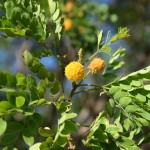Little-leaf Lead Tree, Golden Ball Lead Tree
Leucaena retusa
Fabaceae (Legume family)
Description
Little-leaf Lead Tree is a small tree or shrub with single or multiple stems in the Legume Family (Fabaceae) that grows up to 25 ft or 7.6 m tall and 8 inches or 20 cm in diameter. Its bark remains gray to brown throughout its growth but changes from smooth to scaly. The Natural Resources Conservation Service considers it “an important species for wildlife and restoring native habitat in the Hill Country of West Texas.” Its leaves are bipinnately compound and have 2 to 5 pairs of pinnae each with 3 to 8 pairs of oblong, bright, blue-green leaflets that are 0.5 to 0.75 inches or 0.8 to 2.5 cm long. The leaflets are sometimes notched at the tips. In the spring, it begins to explode with many bright yellow-gold round clusters of flowers and will continue to sporadically bloom new flowers into October. The flowers are balls with a diameter of 1 to 1.2 inches or 2.5 to 3 cm borne on stout axillary peduncles. Large flushes of flowers may occur after rainfall. The fruit is a paper-thin, green pod that matures to brown. Pods measure around 4 to 10 inches or 10 to 25 cm long and mature in August. The pods contain numerous small brown seeds. Little-leaf Lead Tree’s leaves are very palatable and provide excellent forage for deer and livestock. Their pod’s high protein seeds are desirable to wildlife and livestock. Butterflies and bees use flowers as a nectar source, but it is not considered an important source of honey.Habitat
Little-leaf Lead Tree is found in poor, dry, rocky limestone soils and occasionally on hillsides and roadsides. It is well adapted to poor soil and hot, dry sites. It prefers good drainage and is drought tolerant. This species makes an attractive ornamental plant and is easily grown from seed.Images
Plant Characteristics
Flower Color: Yellow
Seed Type: Bean/Pod
Duration: Perennial
Stem Texture: Hairless/Smooth
Growth Habit: Shrub (Woody)
Leaf Shape
 : Bipinnately Compound
: Bipinnately Compound
Season: Warm
Distribution
 : 07 - Edwards Plateau, 10 - Trans-Pecos
: 07 - Edwards Plateau, 10 - Trans-Pecos
Distributions
Distribution refers to the ecological region in Texas that a plant has been found. You can also view a clickable map.
Collection: Brush and Weeds






